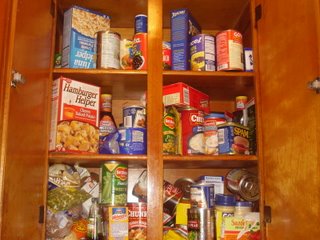 Now that you have your basic equipment and the vocabulary for cooking (see How to Cook-1), you're ready to stock your pantry basics, nail down some cooking essentials, and start off with some basic recipes. Next How-To? How to create menues for the week to maximize your food dollar and your cooking time.
Now that you have your basic equipment and the vocabulary for cooking (see How to Cook-1), you're ready to stock your pantry basics, nail down some cooking essentials, and start off with some basic recipes. Next How-To? How to create menues for the week to maximize your food dollar and your cooking time.Stocking Your Pantry (including the fridge)
It's efficient in both time and money to have a pantry stocked with certain things. Coupon afficiandos swear by the savings of buying in bulk and by sales coordination. Chefs swear by the importance of a well-kept pantry.
There are several sites with options on what to include: ehow.com, homemakers.com, wholefoodsmarket.com. These lists can be long, expanding as they venture into ethnic areas: Thai, Mexican, etc. Over time, you can add things like curry powder to your kitchen; it's not necessary to be international at the get-go.
Must-haves:
Canned tomatoes - great for sauces, soups, cassaroles
Tomato sauce, tomato paste - similar use to the canned, paste is a thickener
Broth - have chicken, beef, and vegetable on hand, flavoring for rice, soup, mashed potatoes, etc.
Dried pasta - at least one noodle (spagetti) for light sauces, and one tube (penne) for thick sauces, salads, cassaroles
Rice - start with the basics, you can graduate to a risotto
Canned Fish - tuna for salads, cassaroles, sandwiches; salmon for croquettes
Canned Beans - have black, cannellini, pinto, more on hand. Tons of uses.
Peanut Butter - make sauces, dips, sandwiches, desserts
Bread Crumbs - filling for cakes (bean, meat), loaves (meatloaf)
Spices - salt, pepper, garlic powder, onion powder, ginger, cumin, chili powder, paprika (sweet), pepper sauce, pepper flakes, soy sauce, wine vinegar, cinnamon, basil, oregano, vanilla extract
Flour - for baking, thickening
Sugar - for baking, sweetening (unless you're game for stevia)
Oils - Extra Virgin Olive Oil for salads, low-heat cooking; vegetable oil for cooking at higher heat; if you are going to stir fry, must use peanut oil - it takes the highest heat before burning.
Ketchup - condiment, flavoring
Mayonaise - condiment, flavoring
Mustard - condiment, flavoring
Tea Bags
Coffee
Bread
Produce - fresh fruits and veggies that you like, don't buy farther than 5 days ahead. Dark green lettuce, tomatoes, onions, garlic, fruit in season are staples
Milk or Milk Substitute - beverage, baking, adding to soups, sauces
Butter
Nuts - freeze 'em
Cooking Essentials
Boiling Water: Put the pot on to boil and leave it. Don't add salt until the bubble are bouncing on the top, or the salt will scrape the bottom of the pot. Simmer is little bitty bubbles, slow movement. Boiling is a party.
For more essentials, there is a great, easy list at eHow.com.
Basic Recipes
Your goal is to be able to whip up a meal or two without having to check the cookbook. Until then, there are several sites with easy recipes for you: basicrecipes.com, mealsforyou.com, foodnetwork.com
Equipment
You don't need most of what they sell. That commercial for the hot tea maker? No. However, a manual can opener is a must, as are a corkscrew and a bottle top opener. A blender and a mixer (hand mixer is fine to start, you don't have to have a pink KitchenAid) are good to have, but elbow grease works just fine if you don't.
1 comment:
Good post.
I was surfing the net, the other day, for a cheap and reliable internet phone service (Voip) and came across one that is cheaper than Vonage and just as good.
Anyone interested can check them out at Via Talk .
Post a Comment